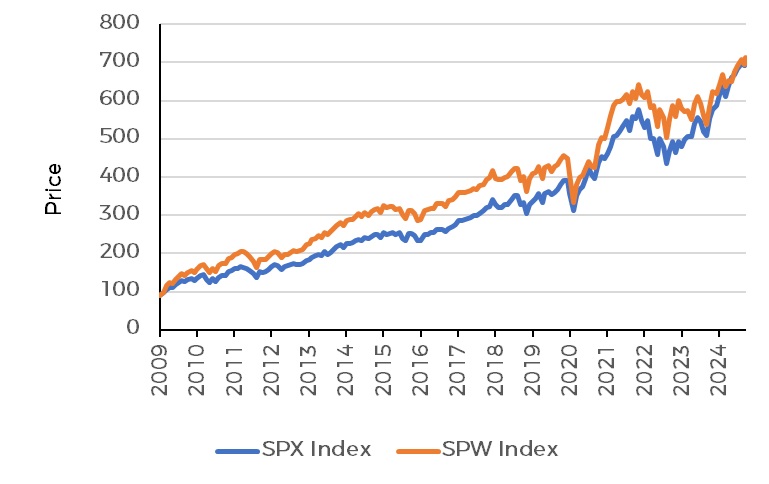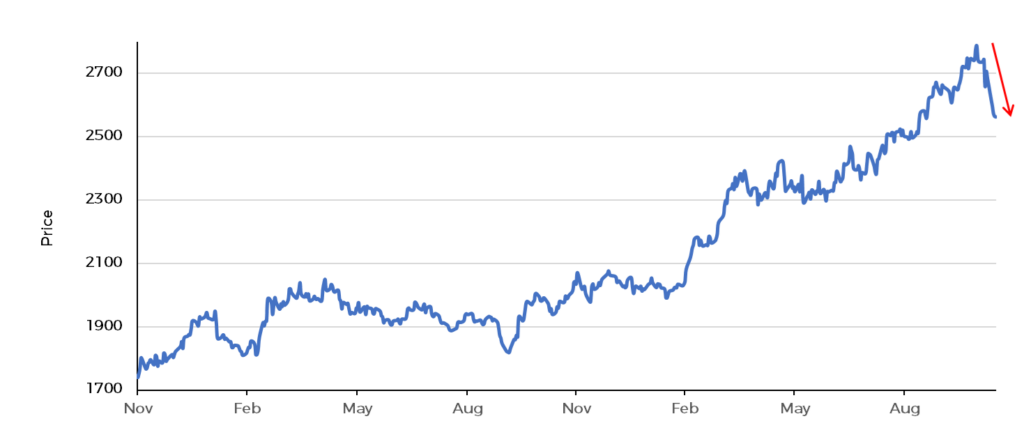Neil Birrell, Premier Miton’s Chief Investment Officer and lead manager of the Diversified fund range, outlines why and how the exposure to US equities has been increased.

In favour; US equities, upping the ante
There has been so much going on in politics, economics and financial markets globally it has been difficult to keep up. It’s not just the number of events, it’s the scale and potential ramifications of them that is notable, some of them are potentially seismic in their impact.
The aim of this update is not to run through thoughts on the UK Budget, the Fed or Bank of England’s interest rate cuts, the poor UK GDP data for the third quarter, the election called in Germany, the corporate reporting season or even details of the US election. It is to outline a meaningful position we have taken across the Diversified fund range.
In our In favour / out of favour note at the start of October, we discussed the big reduction we made in the UK equity portfolio, with the proceeds switched into the global ex-UK equity portfolio. This new position is much along the same lines.
In the immediate aftermath of the US election, we reviewed our thoughts on how the result may play out across different asset classes, sectors and regions. There was lots of chat about the “Trump trade” relating to trade tariffs, particularly involving China and Europe, fossil fuels, renewable energy and importantly the US domestic economy.
In our deliberations we just kept coming back to the same place; Trump policies would surely be good for US equities! But which ones? Companies with a domestic focus looked to be the biggest beneficiaries. If you look at the factsheets for the four Diversified growth funds, you will see that around 45% of the equity exposure is in the US. It’s quite a lot more for the Diversified Sustainable Growth Fund, but less for the Diversified Income Fund.
We decided to allocate more to US equities, particularly those we thought would benefit the most. There were different ways we could do that. First of all, to the get the US weighting up, we could use some cash, sell something to fund it or use a derivative. We didn’t want to change the balance within the global ex-UK equity portfolio or to sell US stocks we liked to buy others. Therefore we used derivative call options on the S&P 500 Equal Weight Index (SPW). This is the same 500 companies as the S&P 500 Index (SPX), in which the companies are market-cap weighted.
This means the SPW has much, much less focus on the Magnificent 7, which only account for 1.4% of it, and much more exposure to more domestically orientated companies. The SPW has done better in periods of economic expansion in the past.
SPX vs SPW 27.02.2009 – 15.11.2024, rebased to 100

Source: Bloomberg data, 27.02.2009 – 15.11.2024, rebased to 100, for SPX Index (S&P 500 Index) and SPW Index (S&P 500 Equal Weight Index). Past performance is not a reliable indicator of future returns.
As you can see from the chart, the SPW did much better than the SPX in the recovery from the global financial crisis from 2009 onwards, worse in the COVID-induced economic collapse in 2020, then better again in the post-COVID recovery, before lagging badly as higher inflation and interest rates took hold, when the Magnificent 7 drove indices.
We believe the conditions are in place for the SPW to perform well, as Trump policies get reflected in markets. Therefore, we bought call options, which gives us exposure without having to adjust asset allocation of the funds. It provides effective exposure of 5% of each fund to the SPW (at the time of purchase), through to 21 February 2025, for the approximate cost of 25bps of the value of each fund. Of course, for it to work, the SPW has to go up, but we believe the risk / reward profile of the position is attractive and the worst that can happen is the option premium (25bps) is lost. We will actively manage the exposure over the period.
This shows the benefit of using derivatives to give exposures where we want them, without making wholesale portfolio changes, quickly, cheaply and effectively.
Out of favour; gold
For those of you that know the Diversified funds, you will know that we have stayed clear of gold as a portfolio diversifier or as an investment. We have no expertise in it, don’t really understand what drives the price and believe we can find better alternatives.
That has been a mistake over the last two years, but as the “Trump trade” has taken hold, gold has sharply reversed. We don’t know what will happen next, but I remain happy that we don’t have any exposure.
Gold; 15.11.2022 – 15.11.2024

Source: Bloomberg data, 15.11.2022 – 15.11.2024 XAU Currency (Gold Spot $/Oz). Past performance is not a reliable indicator of future returns.
Neil Birrell
Premier Miton’s Chief Investment Officer and lead manager of the Diversified fund range

